Abstract
Erypoegin K is an isoflavone isolated from the stem bark of Erythrina poeppigiana. It contains a furan group at the A-ring of the core isoflavone structure and can inhibit the activity of glyoxalase I, an enzyme that catalyzes the detoxification of methylglyoxal (MG), a by-product of glycolysis. In the present study, we found that erypoegin K has a potent cytotoxic effect on human leukemia HL-60 cells. Its cytotoxic effect was much stronger than that of a known glyoxalase I inhibitor S-p-bromobenzylglutathione cyclopentyl diester. Conversely, erypoegin K demonstrated weak cytotoxicity toward normal human peripheral lymphocytes. The treatment of HL-60 cells with erypoegin K significantly induced caspase-3 activity, whereas the pretreatment of the cells with caspase-3 inhibitor suppressed erypoegin K-induced cell death. Furthermore, nuclear condensation and apoptotic genome DNA fragmentation were observed in erypoegin K-treated HL-60 cells. These results indicated that the observed cell death was mediated by apoptosis. In addition, the toxic compound MG was highly accumulated in the culture medium of erypoegin K-treated HL-60 cells, suggesting that cell apoptosis was triggered by extracellular MG. The present study showed that erypoegin K has a potent apoptosis-inducing effect on cancerous cell lines, such as HL-60.








Similar content being viewed by others
References
Tanaka H, Etoh H, Shimizu H, Oh-Uchi T, Terada Y, Tateishi Y (2001) Erythrinan alkaloids and isoflavonoids from Erythrina poeppigiana. Planta Med 67:871–873
Tanaka H, Oh-Uchi T, Etoh H, Shimizu H, Tateishi Y (2002) Isoflavonoids from the roots of Erythrina poeppigiana. Phytochemistry 60:789–794
Tanaka H, Oh-Uchi T, Etoh H, Sako M, Sato M, Fukai T, Tateishi Y (2003) An arylbenzofuran and four isoflavonoids from the roots of Erythrina poeppigiana. Phytochemistry 63:597–602
Tanaka H, Etoh H, Kulkarni A, Fukai T (2004) Phenolic constituents and alkaloids from Erythrina species. Recent Res Devel Phytochem 8:83–116
Tanaka H, Oh-Uchi T, Nitanda T, Baba M, Etoh H, Shimizu H (2002) Prenylated cinnamylphenols, HIV-1 replication inhibitors, from Erythrina poeppigiana. Ite Lett Batter New Technol Med 3:612–615
Sato M, Tanaka H, Yamaguchi R, Oh-Uchi T, Etoh H (2003) Erythrina poeppigiana-derived phytochemical exhibiting antimicrobial activity against Candida albicans and methicillin-resistant Staphylococcus aureus. Lett Appl Microbiol 37:81–85
Sato M, Tanaka H, Tani N, Nagayama M, Yamaguchi R (2006) Different antibacterial actions of isoflavones isolated from Erythrina poeppigiana against methicillin-resistant Staphylococcus aureus. Lett Appl Microbiol 43:243–248
Hikita K, Yamada S, Shibata R, Katoh M, Murata T, Kato K, Tanaka H, Kaneda N (2015) Inhibitory Effect of isoflavones from Erythrina poeppigiana on the growth of HL-60 human leukemia cells through inhibition of glyoxalase I. Nat Prod Commun 10:1581–1584
Djiogue S, Halabalaki M, Alexi X, Njamen D, Fomum ZT, Alexis MN, Skaltsounis A-L (2009) Isoflavonoids from Erythrina poeppigiana: evaluation of their binding affinity for the estrogen receptor. J Nat Prod 72:1603–1607
Djiogue S, Halabalaki M, Njamen D, Kretzschmar G, Lambrinidis G, Hoepping J, Raffaelli FM, Mikros E, Skaltsounis A-L, Vollmer G (2014) Erythroidine alkaloids: a novel class of phytoestrogens. Planta Med 80:861–869
Hikita K, Tanaka H, Murata T, Kato K, Hirata M, Sakai T, Kaneda N (2014) Phenolic constituents from stem bark of Erythrina poeppigiana and their inhibitory activity on human glyoxalase I. J Nat Med 68:636–642
Thornalley PJ (1990) The glyoxalase system: new developments towards functional characterization of a metabolic pathway fundamental to biological life. Biochem J 269:1–11
Racker E (1951) The mechanism of action of glyoxalase. J Biol Chem 190:685–696
Warburg O (1956) On respiratory impairment in cancer cells. Science 124:269–270
Rulli A, Carli L, Romani R, Baroni T, Giovannini E, Rosi G, Talesa V (2001) Expression of glyoxalase I and II in normal and breast cancer tissues. Breast Cancer Res Treat 66:67–72
Ranganathan S, Tew KD (1993) Analysis of glyoxalase-I from normal and tumor tissue from human colon. Biochim Biophys Acta 1182:311–316
Sakamoto H, Mashima T, Sato S, Hashimoto Y, Yamori T, Tsuruo T (2001) Selective activation of apoptosis program by S-p-bromobenzylglutathione cyclopentyl diester in glyoxalase I-overexpressing human lung cancer cells. Clin Cancer Res 7:2513–2518
Hu X, Yang X, He Q, Chen Q, Yu L (2014) Glyoxalase 1 is up-regulated in hepatocellular carcinoma and is essential for HCC cell proliferation. Biotechnol Lett 36:257–263
Zhang S, Liang X, Zheng X, Huang H, Chen X, Wu K, Wang B, Ma S (2014) Glo1 genetic amplification as a potential therapeutic target in hepatocellular carcinoma. Int J Clin Exp Pathol 7:2079–2090
Bair WB 3rd, Cabello CM, Uchida K, Bause AS, Wondrak GT (2010) GLO1 overexpression in human malignant melanoma. Melanoma Res 20:85–96
Sakamoto H, Mashima T, Kizaki A, Dan S, Hashimoto Y, Naito M, Tsuruo T (2000) Glyoxalase I is involved in resistance of human leukemia cells to antitumor agent-induced apoptosis. Blood 95:3214–3218
Thornalley PJ, Rabbani N (2011) Glyoxalase in tumourigenesis and multidrug resistance. Semin Cell Dev Biol 22:318–325
Tanaka T, Kuramitsu Y, Wang Y, Baron B, Kitagawa T, Tokuda K, Hirakawa K, Yashiro M, Naito S, Nakamura K (2013) Glyoxalase 1 as a candidate for indicating the metastatic potential of SN12C human renal cell carcinoma cell clones. Oncol Rep 30:2365–2370
Thornalley PJ, Edwards LG, Kang Y, Wyatt C, Davies N, Ladan MJ, Double (1996) Antitumour activity of S-p-bromobenzylglutathione cyclopentyl diester in vitro and in vivo. Inhibition of glyoxalase I and induction of apoptosis. Biochem Pharmacol 51:1365–1372
Vince R, Wadd WB (1969) Glyoxalase inhibitors as potential anticancer agents. Biochem Biophys Res Commun 35:593–598
Desai KM, Wu L (2008) Free radical generation by methylglyoxal in tissues. Drug Metabol Drug Interact 23:151–173
Kalapos MP (2008) The tandem of free radicals and methylglyoxal. Chem Biol Interact 171:251–271
Talukdar D (2008) A brief critical overview of the biological effects of methylglyoxal and further evaluation of a methylglyoxal-based anticancer formulation in treating cancer patients. Drug Metabol Drug Interact 23:175–210
Kang Y, Edwards LG, Thornalley PJ (1996) Effect of methylglyoxal on human leukaemia 60 cell growth: modification of DNA G1 growth arrest and induction of apoptosis. Leuk Res 20:397–405
Okado A, Kawasaki Y, Hasuike Y, Takahashi M, Teshima T, Fujii J, Taniguchi N (1996) Induction of apoptotic cell death by methylglyoxal and 3-deoxyglucosone in macrophage-derived cell lines. Biochem Biophys Res Commun 225:219–224
Seo K, Ki SH, Shin SM (2014) Methylglyoxal induces mitochondrial dysfunction and cell death in liver. Toxicol Res 30:193–198
Chan WH, Wu HJ, Shiao NH (2007) Apoptotic signaling in methylglyoxal-treated human osteoblasts involves oxidative stress, c-Jun N-terminal kinase, caspase-3, and p21-activated kinase 2. J Cell Biochem 100:1056–1069
Boyum A (1968) Isolation of mononuclear cells and granulocytes from human blood. Scand J Clin Lab Invest Suppl 97:77–89
Chaplen FWR, Fahl WE, Cameron DC (1996) Method for determination of free intracellular and extracellular methylglyoxal in animal cells grown in culture. Anal Biochem 238:171–178
Acknowledgements
This work was partly supported by a Grant-in-Aid for Scientific Research (C) (JP16K08311) from the Ministry of Education, Culture, Sports, Science and Technology of Japan.
Author information
Authors and Affiliations
Corresponding author
Ethics declarations
Conflict of interest
The authors declare no conflicts of interest.
Rights and permissions
About this article
Cite this article
Hikita, K., Hattori, N., Takeda, A. et al. Potent apoptosis-inducing activity of erypoegin K, an isoflavone isolated from Erythrina poeppigiana, against human leukemia HL-60 cells. J Nat Med 72, 260–266 (2018). https://doi.org/10.1007/s11418-017-1147-9
Received:
Accepted:
Published:
Issue Date:
DOI: https://doi.org/10.1007/s11418-017-1147-9




